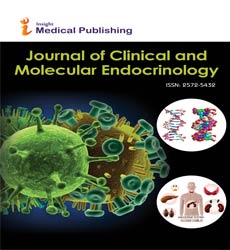Hormonal Regulation of Bone Health: Clinical Insights into Osteoporosis
Rosita Hills
Department of Physical Medicine and Rehabilitation, Mackay Memorial Hospital, Taipei, Taiwan
Published Date: 2025-02-28DOI10.36648/2572-5432/10.1.004
Corresponding author:
Rosita Hills,
Department of Physical Medicine and Rehabilitation, Mackay Memorial Hospital, Taipei, Taiwan,
E-mail: hills.rose@mackay.tw
Received Date: February 01, 2025, Manuscript No. ipjcme-25-20472; Editor assigned date: February 03, 2025, PreQC No. ipjcme-25-20472 (PQ); Reviewed date: February 14, 2025, QC No. ipjcme-25-20472; Revised date: February 21, 2025, Manuscript No. ipjcme-25-20472 (R); Published date: February 28, 2025, DOI: 10.36648/2572-5432/10.1.004
Citation: Hills R (2025) Hormonal Regulation of Bone Health: Clinical Insights into Osteoporosis. J Clin Mol Endocrinol Vol: 10 No 1:4.
Introduction
Bone health is maintained through a delicate balance between bone formation and resorption, a process regulated not only by mechanical and nutritional factors but also by intricate hormonal signaling. Disruptions in hormonal regulation play a pivotal role in the development of osteoporosis; a systemic skeletal disorder characterized by low bone mass and increased fracture risk. Understanding the endocrine regulation of bone metabolism provides critical insights into the pathogenesis, prevention, and treatment of osteoporosis [1].
Description
Parathyroid Hormone (PTH) is a central regulator of calcium and phosphate homeostasis, exerting dual effects on bone. Intermittent elevations of PTH stimulate osteoblast activity and bone formation, whereas chronic elevations promote osteoclast-mediated bone resorption. In osteoporosis, particularly secondary forms related to hyperparathyroidism, excessive PTH signaling contributes to trabecular bone loss and increased fracture risk. Clinical use of PTH analogs, such as teriparatide, demonstrates the therapeutic potential of manipulating PTH pathways to enhance bone formation [2].
Estrogen is another critical hormone in bone health, particularly in women. Estrogen deficiency after menopause accelerates bone turnover, leading to a net loss of bone mass. Estrogen acts by suppressing osteoclast activity through modulation of RANKL (receptor activator of nuclear factor kappa-B ligand) and Osteoprotegerin (OPG) signaling, thereby maintaining bone density. The decline in estrogen is the primary driver of postmenopausal osteoporosis. Hormone replacement therapy and Selective Estrogen Receptor Modulators (SERMs) have been clinically employed to mitigate this effect, though their risks and benefits must be carefully weighed [3].
In men, testosterone contributes to bone health both directly and indirectly. It stimulates osteoblast activity and is also converted to estrogen via aromatization, which further supports bone maintenance. Hypogonadism in men has been associated with reduced bone mineral density and higher susceptibility to fractures. Testosterone replacement therapy, when clinically indicated, can improve bone health, although its use requires careful evaluation due to potential cardiovascular and prostate-related risks. [4].
Other hormones, such as calcitonin, Growth Hormone (GH), Insulin-Like Growth Factor 1 (IGF-1), and thyroid hormones, also influence bone remodeling. Calcitonin inhibits osteoclast-mediated bone resorption, though its role in clinical practice is limited. GH and IGF-1 promote longitudinal bone growth and remodeling, while excess thyroid hormones increase bone resorption and fracture risk. These multifaceted hormonal influences highlight the complexity of endocrine regulation in skeletal integrity and the need for comprehensive evaluation of hormonal status in patients with osteoporosis. Advances in our understanding of hormonal regulation of bone health are paving the way for innovative diagnostic and therapeutic approaches in osteoporosis. Future research is likely to focus on precision medicine, where individualized hormonal profiling could guide targeted interventions, maximizing efficacy while minimizing adverse effects. The development of novel agents that selectively modulate hormonal pathways, such as tissue-specific estrogen receptor modulators or next-generation parathyroid hormone analogs, holds promise for safer and more effective management of bone loss [5].
Conclusion
Osteoporosis is a multifactorial disease in which hormonal regulation plays a central role in the pathogenesis and progression of bone loss. Estrogen deficiency, altered PTH dynamics, testosterone insufficiency, and dysregulation of other hormones converge to disrupt skeletal homeostasis. Clinically, therapies targeting these hormonal pathways ranging from PTH analogs and SERMs to testosterone replacement offer effective options for managing osteoporosis when applied with individualized risk assessment. A thorough understanding of hormonal regulation of bone health provides clinicians with valuable strategies to prevent fractures, preserve mobility, and improve quality of life in patients at risk for or living with osteoporosis. Overall, the future of osteoporosis care lies in a multidisciplinary approach that combines endocrinology, molecular biology, and technology to provide holistic, patient-centered solutions aimed at preserving skeletal integrity across the lifespan.
Acknowledgement
None.
Conflict of Interest
None.
References
- Eriksen EF (1986). Normal and pathological remodeling of human trabecular bone: three dimensional reconstruction of the remodeling sequence in normals and in metabolic bone disease. Endocr Rev 7: 379-408.
Google Scholar Cross Ref Indexed at
- Hattner R, Epker BN, Frost HM (1965). Suggested sequential mode of control of changes in cell behaviour in adult bone remodelling. Nature 206: 489-490.
Google Scholar Cross Ref Indexed at
- Frost HM (1990). Skeletal structural adaptations to mechanical usage (SATMU): 1. Redefining Wolff's law: the bone modeling problem. Anat Rec 226: 403-413.
Google Scholar Cross Ref Indexed at
- Xi L, Song Y, Wu W, Qu Z, Wen J, et al. (2020). Investigation of bone matrix composition, architecture and mechanical properties reflect structure-function relationship of cortical bone in glucocorticoid induced osteoporosis. Bone 136: 115334.
Google Scholar Cross Ref Indexed at
- Sbaihi M, Rousseau K, Baloche S, Meunier F, Fouchereau-Peron M, et al. (2009). Cortisol mobilizes mineral stores from vertebral skeleton in the European eel: an ancestral origin for glucocorticoid-induced osteoporosis?. J Endocrinol 201: 241.
Open Access Journals
- Aquaculture & Veterinary Science
- Chemistry & Chemical Sciences
- Clinical Sciences
- Engineering
- General Science
- Genetics & Molecular Biology
- Health Care & Nursing
- Immunology & Microbiology
- Materials Science
- Mathematics & Physics
- Medical Sciences
- Neurology & Psychiatry
- Oncology & Cancer Science
- Pharmaceutical Sciences
